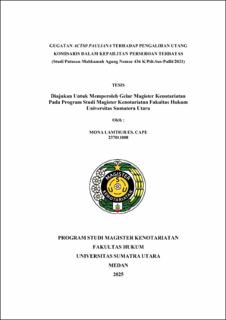| dc.contributor.advisor | Sunarmi | |
| dc.contributor.advisor | Siregar, Mahmul | |
| dc.contributor.author | Cape, Mona Lamtiur ES | |
| dc.date.accessioned | 2025-07-31T01:47:02Z | |
| dc.date.available | 2025-07-31T01:47:02Z | |
| dc.date.issued | 2025 | |
| dc.identifier.uri | https://repositori.usu.ac.id/handle/123456789/107907 | |
| dc.description.abstract | The separation of assets between corporate officers and the legal entity is a fundamental principle in limited liability company law. However, in practice, personal debts of commissioners are sometimes transferred to the company, potentially harming creditors, particularly in the event of bankruptcy. This study seeks to answer the following questions: What is the legality of transferring a commissioner’s personal debt to the company and its legal consequences on bankruptcy assets? Can the transfer of personal debt to a limited liability company (PT) prior to bankruptcy ruling be used as grounds for an actio pauliana lawsuit? How is the legal application reflected in the judicial considerations and decision of the Supreme Court in Decisions No. 7/Pdt.Sus-Actio Pauliana/2020/PN.Niaga.Smg jo. No. 23/Pdt.Sus-Pailit/2018/PN.Niaga.Smg jo. No. 1/Pdt.Sus-PKPU/2018/PN.Niaga.Smg and No. 436 K/Pdt.Sus-Pailit/2021 with respect to the transfer of a commissioner’s debt in bankruptcy.
This research employs a normative juridical method, relying on legal norms through library research to obtain secondary data in the form of primary, secondary, and tertiary legal materials related to the problem studied. It is descriptive in nature and analyzed qualitatively.
The findings conclude that the transfer of a commissioner’s personal debt to a limited liability company is generally invalid and may be annulled through actio pauliana if the company is declared bankrupt. Such actions violate the principle of asset separation, create conflicts of interest, and potentially harm creditors. The Supreme Court affirmed that even in the presence of a composition agreement (homologation) during the suspension of debt payment obligations (PKPU), the curator may still file an actio pauliana claim to recover assets detrimental to the bankruptcy estate, as the purpose of actio pauliana is to protect the interests of all creditors and is not bound by any previously agreed settlement. | en_US |
| dc.language.iso | id | en_US |
| dc.publisher | Universitas Sumatera Utara | en_US |
| dc.subject | Actio Pauliana | en_US |
| dc.subject | Debt Transfer | en_US |
| dc.subject | Bankruptcy | en_US |
| dc.title | Gugatan Actio Pauliana terhadap Pengalihan Utang Komisaris dalam Kepailitan Perseroan Terbatas (Studi Putusan Mahkamah Agung Nomor 436 K/Pdt.Sus-Pailit/2021) | en_US |
| dc.title.alternative | Actio Pauliana Lawsuit Against the Transfer of a Commissioner's Debt in the Bankruptcy of a Limited Liability Compan (A Case Study of Supreme Court Decision No. 436 K/Pdt.Sus-Pailit/2021) | en_US |
| dc.type | Thesis | en_US |
| dc.identifier.nim | NIM237011008 | |
| dc.identifier.nidn | NIDN0015026304 | |
| dc.identifier.nidn | NIDN0020027303 | |
| dc.identifier.kodeprodi | KODEPRODI74102#Kenotariatan | |
| dc.description.pages | 134 Pages | en_US |
| dc.description.type | Tesis Magister | en_US |
| dc.subject.sdgs | SDGs 16. Peace, Justice And Strong Institutions | en_US |


